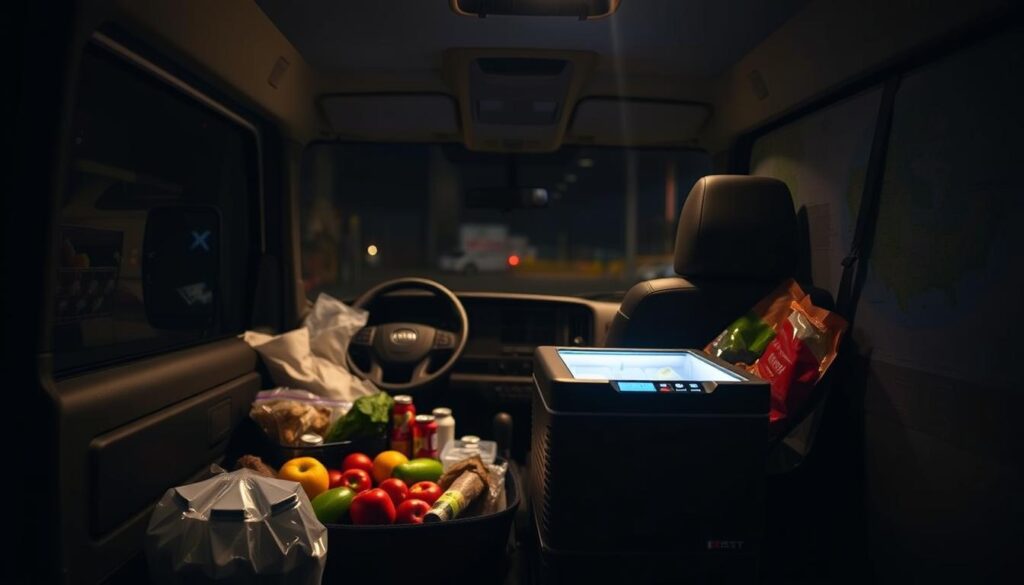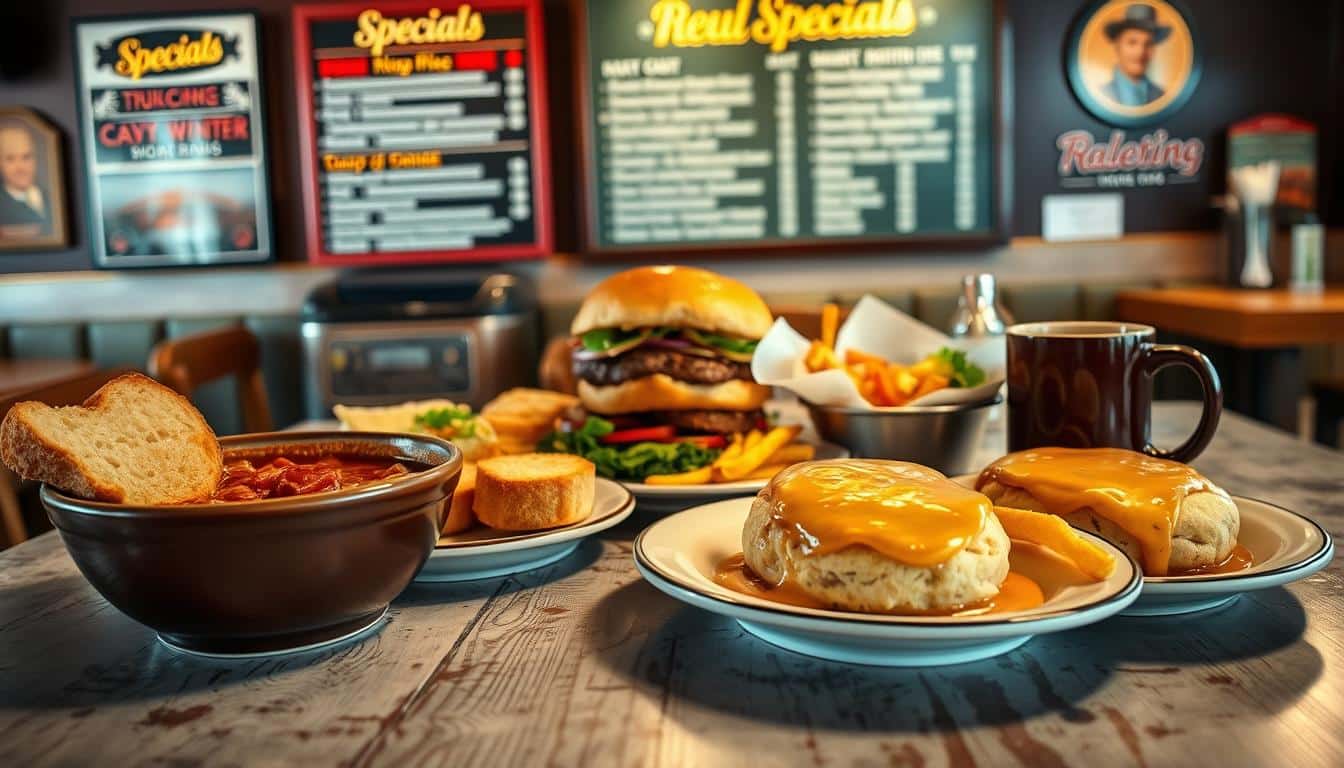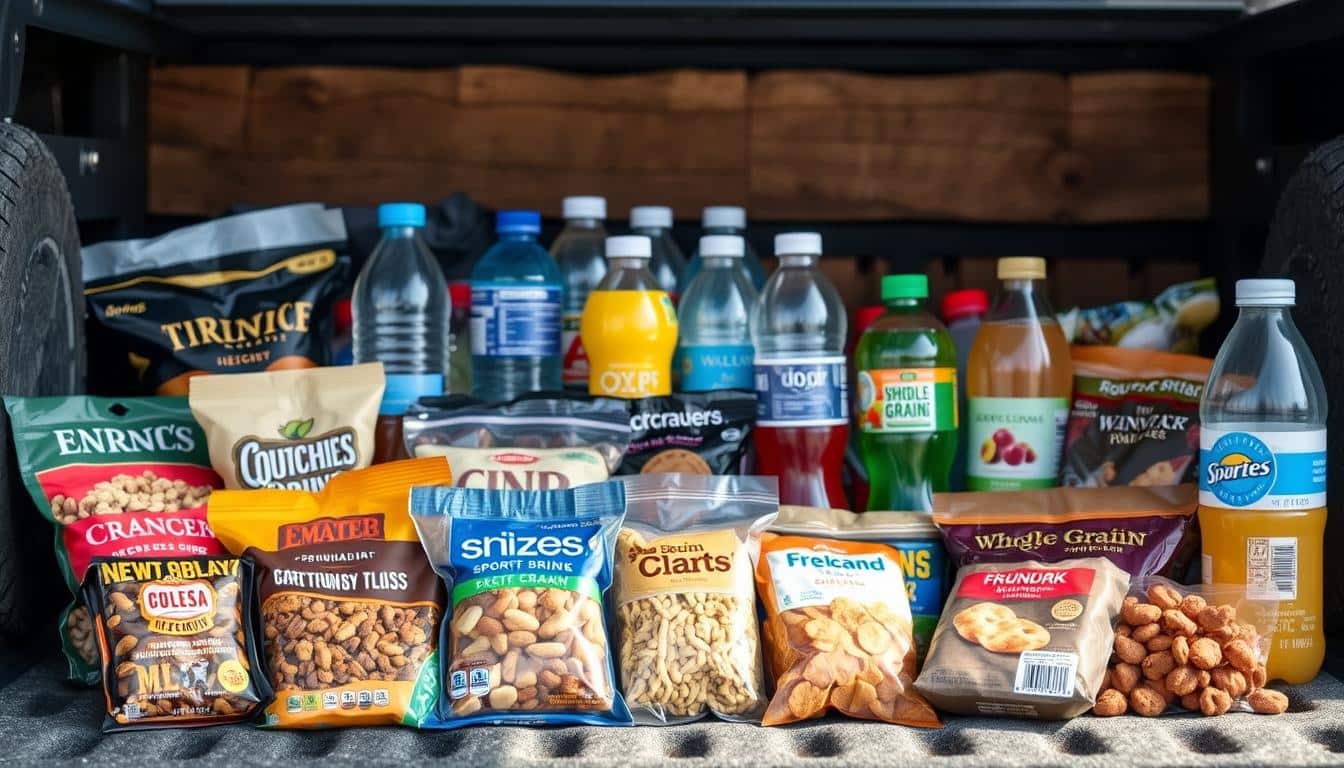Truck drivers often find few and pricey food options during their trips. By making meals with a slow cooker or no-cook items, they gain control. These recipes save money, bring comfort, and reduce fast food stops.
Many companies and job sites, like Swift Transportation and OpenOTR, share tips for road life planning. With simple recipes and a small slow cooker powered by the truck, meals for one or two are easy. This setup is perfect, even when work schedules shift.
This article will explore easy meal prep for truck drivers: essential gear, simple recipes, meals to make ahead, and safe cooking practices. Choosing home-cooked meals over gas-station snacks boosts energy, health, and savings on long trips.
Why Meal Planning Matters for Truck Drivers
Long hauls challenge food choices every day. Meal planning for truck drivers turns this challenge into a routine. It lets drivers pack healthy meals. These meals boost energy, ease digestion, and reduce stress during tight schedules.
Health and energy benefits of home-prepped meals
Preparing meals ahead of time helps manage portion sizes and ingredients. Eating simple meals with lean protein, whole grains, and vegetables keeps blood sugar stable. This helps drivers stay focused.
Drivers notice fewer energy dips when they avoid fried or sugary roadside foods. Instead, they choose balanced, home-prepped meals.
Cost savings compared to frequent restaurant and truck stop purchases
Daily dining out increases spending. Meal planning lets truck drivers cook in batches and use pre-cooked proteins. This slashes daily food expenses.
Using a small slow cooker or a 12V lunchbox oven saves money. It also means eating better than what you find at truck stops.
How routines help avoid unhealthy snacking and weight gain
Having set meal times cuts down on spontaneous diner and convenience store visits. A solid meal plan keeps you away from truck stop food and drive-thrus during breaks.
Pack snacks like nuts, hard-boiled eggs, and fruit to dodge processed snacks. This helps limit salt and sugar intake, battling weight gain.
- Batch-cook proteins and portion into containers for the week.
- Use frozen vegetables and canned beans to cut prep time.
- Stay hydrated with water to curb false hunger signals.
- Follow carrier schedules or dedicated routes to time meals around breaks.
Essential Portable Cooking Gear for Truckers
Adding reliable, small appliances to your cab makes long trips better and healthier. Pick items that fit your energy setup, cooking style, and space. Here are some top choices and tips for keeping food hot, fresh, and easy to make.
Portable slow cooker and 12V lunchbox oven pros and cons
A portable slow cooker is great for making stews, chili, and tender meat dishes. Small Crock-Pot versions are good for one or two people and work with truck power through an adapter. They save time by cooking meals while you’re resting.
The 12V lunchbox oven is good at warming up pre-cooked food and making small baked dishes. It powers up using the truck and heats up quicker than a slow cooker. However, it uses more electricity. So, drivers should test it and watch their battery use.
Mini fridge/cooler, electric skillet, and small blender recommendations
- Mini fridge for truck: Choose compressor models from Dometic or ARB that are 18–30 liters for your perishables. These fridges maintain even temperatures on the road.
- Portable slow cooker: Go for sizes between 1.5–3 quarts by Hamilton Beach or Crock-Pot for solo meals and easy packing.
- 12V lunchbox oven: RoadPro offers compact versions great for warming food; use them with insulated containers for quicker heating.
- Electric skillet or griddle: An electric skillet provides many options for breakfast and stir-fries. Nonstick ones mean less cleaning.
- Small blender: Try personal blenders by NutriBullet or Ninja for smoothies and sauces. Their pitcher lids double as measuring cups, saving space.
- Essentials: sealable storage boxes, a compact cutting board, good utensils, foil, dish soap, and a quick-dry towel.
Power considerations and safe usage tips in the cab
Make sure your appliances work with the truck’s electrical system before using them. Companies like Swift Transportation offer advice on what devices are ok and how to use them safely. Also, check your truck’s manual for the max inverter size and fused outlet info.
Don’t turn on many high-power appliances at once. Use the right inverters and adapters for your tools and fuse them properly. Keep air vents open, unplug devices when not in use, and never leave things cooking without watching them.
To stay safe, keep an eye on the battery voltage when cooking for a long time. A little battery monitor or a smart inverter that turns off at low voltage can stop the battery from running too low. Regular checks can prevent fires and keep your battery ready for the road.
easy trucker recipes
Life on the road needs meals that are quick, reduce waste, and are enjoyable to eat. These recipes are perfect for small spaces, busy schedules, and limited cab power. Planning ahead means you can enjoy home-cooked tastes without needing a lot of prep time or big kitchen tools.
Slow cooker recipes tailored to small crockpots
Small crockpot dishes are easy to scale down. Use a slow cooker that holds 1.5–3 quarts for meals for one or two people. When scaling down recipes, cut them in half or by two-thirds. Keep liquid levels low to prevent your food from becoming too watery, and check if it’s done sooner than suggested.
Some great dishes to try include shredded chicken seasoned with salsa, a small pot roast with baby carrots, or a delicious batch of pulled pork. These meals are great because they slowly build up their flavors and can be stored in a cooler for eating later.
Make-ahead meals that reheat well in a microwave or lunchbox oven
Preparing meals ahead of time saves driving hours and fits well with work schedules. Pick recipes that stay moist and reheat well. Grilled chicken with quinoa, whole wheat pasta with turkey meatballs, and homemade beef stew are all excellent choices.
Divide your meals into shallow containers to heat them up faster. Using frozen veggies and precooked proteins makes prep quicker and reduces waste. Remember to label your containers with the date to keep track of what’s fresh in a mini-fridge or cooler.
Flexible ingredient swaps for different tastes and portion sizes
Changing ingredients lets you adjust recipes easily. Choose different proteins like chicken, turkey, beef, or tofu. Swap out rice for quinoa or whole wheat pasta to suit your carb and texture preferences.
Add items like salsa, marinara, or soy sauce to change the taste without needing to cook more. To manage your hunger and fit everything in your cooler, divide the food into two or three portions.
- Small slow-cooker tip: reduce broth by 25% for denser sauces.
- Make-ahead trick: cool foods quickly before sealing containers to maintain freshness.
- Swap idea: frozen mixed veggies save time and keep colors bright after reheating.
Slow Cooker Favorites for the Road
Long trips need easy yet tasty meals. These slow cooker recipes are perfect for truckers. They require little prep and are easy to make in small amounts. This means less cooking time and more driving.
Simple Crock Pot Chicken
Try this three-ingredient chicken from Food.com for an easy meal. Just mix chicken breasts, sauce, and seasoning. Set it on low, then forget it. Once done, it’s great with biscuits or hearty bread for a satisfying meal.
Small Batch Pot Roast
This pot roast is perfect for a cozy dinner, adapted from Spark Recipes. It needs just beef, baby carrots, potatoes, and simple ingredients. It’s easy to make in small slow cookers and serves two meals.
Slow Cooker Pulled Pork
Pulled pork is a hit for any meal. Follow Allrecipes for a mix of pork shoulder, barbecue sauce, and root beer. This combination is simple and delicious. Cook it in a small size, then enjoy it on rolls or rice.
Apple Cinnamon Crock Pot Oatmeal
Oatmeal in the crock pot makes for breakfast or dessert. Check out Spark Recipes for an apple cinnamon recipe. It smells amazing and works great with ice cream or in jars for easy breakfast.
- Tip: Brown ground meat at home when possible, then finish in the slow cooker to cut strong odors in the cab.
- Tip: Portion meals into airtight containers so reheating is quick and safe between stops.
- Extra ideas: Slow-cooker chili and beef stew are robust, road-ready options you can adapt to small cookers.
Quick No-Cook and Cold Trucker Meals
Having a good cooler means easy and tasty meals on the road. Cold meals save time and keep you healthy. Make sure to pack proteins, fruits, and quick snacks for long trips.
Turkey and hummus wraps are perfect for fast lunches. Use whole wheat wraps with deli turkey, hummus, spinach, and carrots. They stay fresh in a cooler and taste great cold or warmed in a 12V lunchbox oven.
Add avocado, roasted red peppers, or pepper jack cheese for a kick. Wraps are easy to make, take less space, and are cleaner than regular sandwiches.
Fast protein bowls and salads
Making tuna salad is simple. Just mix it with mayo or Greek yogurt and a bit of mustard. Eat it with crackers, carrot, and celery sticks. It’s great chilled and packs a protein punch.
Chickpea salads are great to keep cool. Mix canned chickpeas with cucumber, olive oil, lemon juice, salt, and pepper. It stays fresh and crunchy in the cooler.
Snack plate lunch ideas
Snack plates are perfect for quick breaks. Include hard-boiled eggs, cheese sticks, nuts, and apple slices with lemon on them. Also, add veggies and hummus for dipping.
These snacks don’t need reheating and are a healthy mix of protein, fat, and fiber. Use reusable containers to keep portions right and cut down on trash.
- Prep tip: portion items into clear containers so choices are visible at a glance.
- Safety tip: swap ice packs every 24 hours and store perishable items under 40°F.
- Speed tip: pre-assemble a few turkey hummus wraps and a batch of tuna salad for truckers at home to streamline weekday meals.
Healthy Breakfast and Snack Ideas for Long Hauls
Simple meals are great for keeping your energy up without spending much at truck stops. Choose food that is easy to store in a cooler and quick to make. Always carry a refillable water jug to drink plenty and skip the sugary beverages.

Overnight oats are perfect for when you’re in a rush. Just mix oats with milk, some chia or flax, and your choice of fruit in a jar. Chill it overnight. Enjoy it cold or warm it up in the morning. For more taste, add peanut butter or cinnamon. It’s an ideal choice for a quick trucker breakfast.
Greek yogurt bowls are super easy. Just add granola and berries to Greek yogurt and keep it cool till you eat. For smoothies, blend protein powder, frozen fruit, and milk. Or mix powder with water in a shaker bottle for an easy drink.
Hard-boiled eggs are a solid protein source and keep well in the cold. Eat them with fruit for a good snack. String cheese and whole-grain crackers also last long and go well together.
- Low-sugar protein bars — check labels for sugar content.
- Roasted chickpeas — crunchy, long-lasting, and filling.
- Mixed nuts (low sodium) — calorie-dense without added sugar.
- Cut veggies with single-serve hummus — fresh and fiber-rich.
For truck drivers, these snacks are smart choices. They’re easy to divide and keep. Add tuna packets, beef jerky with few additives, or Greek yogurt pouches for protein. Change up your snacks weekly to keep things fresh and avoid getting tired of them.
Get your breakfasts and snacks ready before your trip. This makes mornings easier. Having a go-to list of quick breakfast ideas and snacks will save time. It also supports better eating during long drives.
Sample Meal Plans and Grocery List for a Week on the Road
Here’s a one-week meal plan for truckers to make shopping and cooking simpler. It mixes easy breakfasts, lunches you can take with you, and dinners you can reheat. There are tips on how to reheat and store the food. This makes sure your meals are safe and delicious, whether in a truck cab or sleeper.
This sample plan picks foods that store and reheat well. Try to keep sauces separate until you reheat. For warming up, use either a microwave or a 12V lunchbox oven. Remember to stir the food halfway through so it heats up evenly.
- Day 1: Overnight oats with berries (breakfast), turkey and hummus wrap (lunch), crockpot chili with brown rice (dinner).
- Day 2: Greek yogurt + granola (breakfast), tuna salad with crackers (lunch), chicken quinoa bowl with steamed frozen veggies (dinner).
- Day 3: Hard-boiled eggs and whole grain toast (breakfast), deli turkey wrap and carrot sticks (lunch), pasta with turkey meatballs and marinara (dinner).
- Day 4: Overnight oats with peanut butter (breakfast), leftover chili on brown rice (lunch), stir-fry with pre-cooked chicken and frozen mixed vegetables (dinner).
- Day 5: Yogurt bowl with fruit and nuts (breakfast), tuna packet over spinach with crackers (lunch), slow-cooker pulled chicken tacos with salsa (dinner).
- Day 6: Smoothie or Greek yogurt (breakfast), turkey wrap and apple (lunch), grilled chicken breast with quinoa and cucumber-tomato salad (dinner).
- Day 7: Oatmeal or leftover granola bowl (breakfast), snack-plate lunch: cheese sticks, hard-boiled eggs, nuts, fruit (lunch), leftover combos or quick stir-fry (dinner).
Here’s a trucker grocery list that makes packing and restocking fast. It can guide you in making sure you don’t miss anything essential.
- Proteins: grilled chicken breast (pre-cooked or raw to grill), hard-boiled eggs, tuna packets, low-sodium deli turkey, Greek yogurt, string cheese.
- Carbs: whole grain wraps, brown rice, oats, quinoa, whole grain bread, whole-grain crackers.
- Produce: apples, bananas, oranges, berries (fresh or frozen), carrot sticks, baby spinach, cherry tomatoes, cucumbers.
- Extras: hummus, peanut butter, salsa, olive oil, protein bars, a refillable water jug, seasonings, zip-top bags, reusable containers.
Batch-cooking saves truck drivers time and cuts down on waste. Cook your proteins and grains ahead of time. Cool them fast, then split them into stacked containers. You should freeze meals you won’t eat in the first two days. This helps them last longer.
Getting portions right is key. It saves space in your cooler and ensures your meals are well-balanced. Pick containers that are all the same size. Mark each with what meal it is and the date. Put ice packs at the cooler’s bottom to keep everything cold.
- Cook a bunch of brown rice and quinoa. Split them into 1- to 1.5-cup portions.
- Grill or bake chicken breasts. Slice them up and divide into 4–6 ounce portions.
- Make a big pot of chili or stew. Split it into single servings; freeze some.
- Keep sauces in small, tight containers. This keeps food from getting soggy when you reheat it.
Use these portion tips to make the most of your cooler space and keep food fresh. Stack your containers wisely, from largest to smallest. Keep raw foods away from those ready to eat. Doing this saves time and keeps the food tasting good. It also helps you stick with the week-long meal plan without having to stop all the time.
Food Safety and Storage Tips in a Trucker Cab
Food safety on the road starts with simple steps. Using a small slow cooker or a 12V lunchbox oven? Make sure to use fresh ingredients that are stored right. Keep an eye on temperature, how well things are sealed, and how long they stay fresh to stay healthy on the go.

Keeping perishables cold: cooler strategies and ice packs
Pick a good soft cooler or a compact fridge. Use block ice or several ice packs to keep things cold consistently. Put the cooler in a cool spot and open it less often. Check the temperature with a thermometer that’s small and easy to read.
Put raw meat at the bottom and ready-to-eat food on top. Replace ice packs regularly and use frozen meals to fill in. Freeze any food you won’t eat in two days to avoid waste and keep your meals safe.
Safe reheating practices and cross-contamination prevention
Warm up leftovers to 165°F for safety, especially with poultry and most other dishes. It’s best to use a microwave or your lunchbox oven. Try not to reheat food more than once to stop bacteria from growing.
Stop cross-contamination with the right tools and habits. Have different cutting boards for meat and vegetables. Always clean your knives and surfaces. Keep raw food sealed and separate from things like salads and fruits.
Expiration awareness and reducing food waste on the road
Write down the dates on your meals and eat them in order. Use up foods that spoil quickly first and freeze any extra. Check your fridge’s temperature regularly and throw out anything that smells strange or has been too warm for too long.
- Pack only as much as you’ll eat in a session or two.
- Seal food well to keep bugs and bad smells away.
- Always wash your hands before you touch food and after handling raw items.
By following these steps, you make it easier to keep food safe in your truck. This means making sure food stays cold, heating it properly, and avoiding cross-contamination. This all lowers the risk of food-related issues.
Conclusion
Meal prep for truckers makes long trips a chance for better health and saving money. Using a small slow cooker or portable gear lets them enjoy dishes like chicken, pot roast, pulled pork, and oatmeal. These meals are simple to make, store, and they beat fast food and truck stop options.
With some planning and the right tools, cooking on the road is easy for drivers. Employers often help by planning breaks and providing safe ways to power cooking gear. Using these aids helps drivers cook healthy meals. Choices like batch-cooked meals, a small cooler, and easy no-cook meals like wraps and salads make it easier and quicker.
Eating well on the road boosts energy, mood, and overall health. Use this guide’s meal plans, grocery list, and safety tips to avoid junk food. With a little preparation and the right tools, truckers can enjoy homemade meals. This makes eating well while driving more than just possible—it’s a smart choice for every mile.
FAQ
What gear do I need to cook safely in my truck?
Can a slow cooker run off truck power?
What are easy slow-cooker recipes for one person?
How do I store cooked food safely in a truck?
What no-cook meals travel well when I only have a cooler?
How can meal planning save me money and improve health on long hauls?
What are smart snack choices to stay energized and avoid sugar crashes?
How do I reheat meals safely in a truck?
Can I prepare meals ahead of time for a week on the road?
Are there carrier resources that support in-cab meal prep and safe equipment use?
What grocery list should I use for a week of trucking meals?
How can I vary flavors without cooking more on the road?
What safety precautions should I take when using appliances in the cab?
Content created with the help of Artificial Intelligence.



